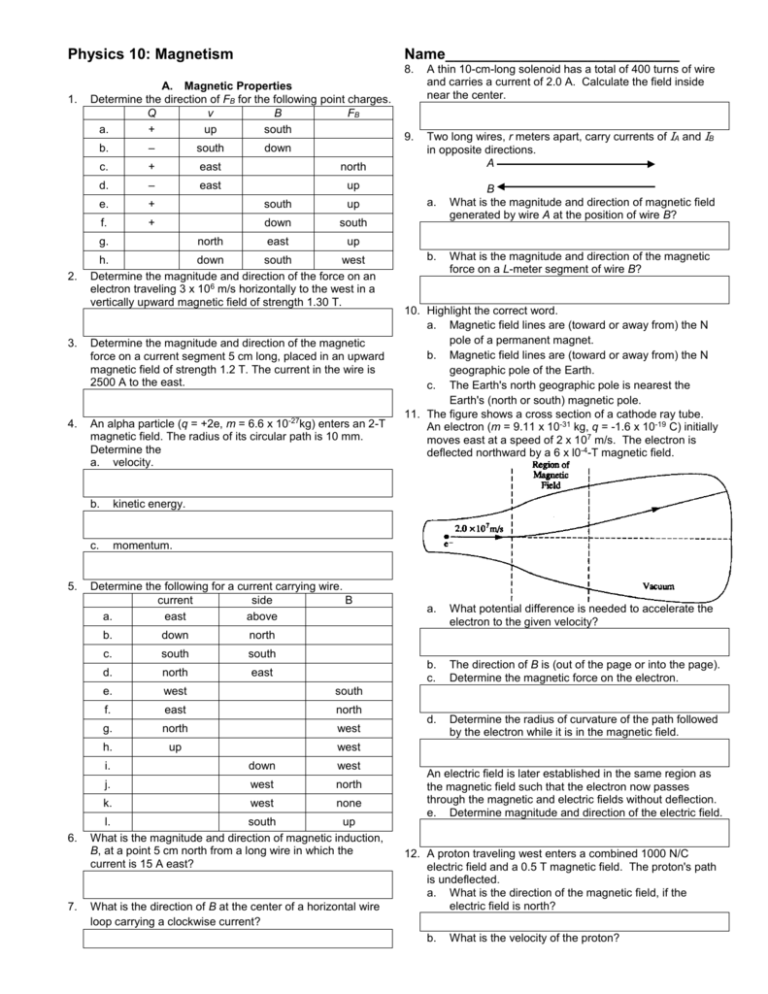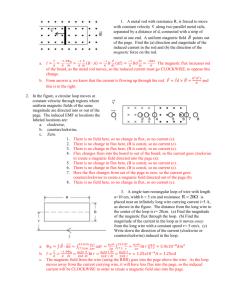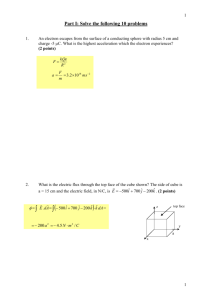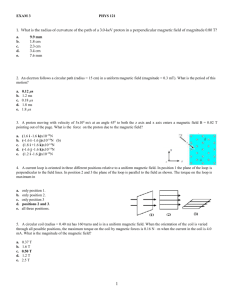Physics
advertisement

Physics 10: Magnetism 1. A. Magnetic Properties Determine the direction of FB for the following point charges. Q v B FB a. + up south b. – south c. + east north d. – east up e. + f. + g. 2. Name____________________________ north down south up down south east up h. down south west Determine the magnitude and direction of the force on an electron traveling 3 x 106 m/s horizontally to the west in a vertically upward magnetic field of strength 1.30 T. 3. Determine the magnitude and direction of the magnetic force on a current segment 5 cm long, placed in an upward magnetic field of strength 1.2 T. The current in the wire is 2500 A to the east. 4. An alpha particle (q = +2e, m = 6.6 x 10-27kg) enters an 2-T magnetic field. The radius of its circular path is 10 mm. Determine the a. velocity. 5. 6. 7. b. kinetic energy. c. momentum. Determine the following for a current carrying wire. current side B a. east above b. down north c. south south d. north east e. west south f. east north g. north west h. up west i. down west j. west north k. west none l. south up What is the magnitude and direction of magnetic induction, B, at a point 5 cm north from a long wire in which the current is 15 A east? What is the direction of B at the center of a horizontal wire loop carrying a clockwise current? 8. A thin 10-cm-long solenoid has a total of 400 turns of wire and carries a current of 2.0 A. Calculate the field inside near the center. 9. Two long wires, r meters apart, carry currents of IA and IB in opposite directions. A a. b. B What is the magnitude and direction of magnetic field generated by wire A at the position of wire B? What is the magnitude and direction of the magnetic force on a L-meter segment of wire B? 10. Highlight the correct word. a. Magnetic field lines are (toward or away from) the N pole of a permanent magnet. b. Magnetic field lines are (toward or away from) the N geographic pole of the Earth. c. The Earth's north geographic pole is nearest the Earth's (north or south) magnetic pole. 11. The figure shows a cross section of a cathode ray tube. An electron (m = 9.11 x 10-31 kg, q = -1.6 x 10-19 C) initially moves east at a speed of 2 x 107 m/s. The electron is deflected northward by a 6 x l0-4-T magnetic field. a. What potential difference is needed to accelerate the electron to the given velocity? b. c. The direction of B is (out of the page or into the page). Determine the magnetic force on the electron. d. Determine the radius of curvature of the path followed by the electron while it is in the magnetic field. An electric field is later established in the same region as the magnetic field such that the electron now passes through the magnetic and electric fields without deflection. e. Determine magnitude and direction of the electric field. 12. A proton traveling west enters a combined 1000 N/C electric field and a 0.5 T magnetic field. The proton's path is undeflected. a. What is the direction of the magnetic field, if the electric field is north? b. What is the velocity of the proton? 13. Determine the magnitude and direction of the magnetic field 1 m west of a long wire with a current of 100 A north. 14. Determine the magnitude and direction of the magnetic field in the center of a thin 0.50-m-long solenoid that has a total of 10,000 turns of wire and carries a current of 6.0 A in a counterclockwise direction. B. Induced emf, E 18. The upward magnetic field through a wire loop changes from 0 T to 3 T in 0.1 s. The area of the loop is 0.01 m 2 and its electrical resistance is 10 . a. Determine B E I b. 15. An electron (m = 9.11 x 10-31 kg, q = -1.60 x 10-19 C), traveling west with a velocity of 1 x 106 m/s enters a magnetic field, B = 1 x 10-4 T that is directed up. Determine a. the radius of the circular path. What is the direction of current? 19. A horizontal wire loop with area = 1 m2 and resistance = 5 , is in a downward 0.5-T, magnetic field. It rotates 90o in 1 s. a. Determine B b. the direction of the path when viewing from above. 16. Wire A carries a 5-A current east. Determine a. the magnitude and direction of the magnetic field 0.5 m north of wire A. b. the magnitude and direction of the magnetic force on a 0.1 m segment of wire B, carrying a 2-A current west that is 0.5 m to the north of wire A. E I b. What is the direction of current? 20. A rod, with an internal resistance of 2 , moves along rails that are 2 m apart through an upward 2-T magnetic field at 10 m/s east. 17. J. J. Thomson's is credited with discovering the electron. He performed an experiment using the apparatus below to determine the me/qe ratio for an electron. a. Calculate the emf generated by the moving rod b. Determine the direction of current in the U-shaped rail and rod in the rod c. Calculate the current through the rod. a. Initial he adjusted the magnetic and electric fields so that the "cathode" rays—electrons would strike the screen at position b. (1) Determine the direction for the following. B between the clockwise current loops d. Calculate the force needed to move the rod. e. Calculate the power needed to move the rod. f. Calculate the electric power generated in the circuit. g. Explain why the answers from parts e and f must be the same. FB on the electron beam E that would keep the electron beam undeflected (2) What is the velocity of the electron in terms of the electric field (E) and magnetic field (B) b. The electric field is turned off. (1) Which path will the electrons follow (a, b or c)? (2) What is the me/qe ratio in terms of B, E and r, the radius of the electron's curved path. 21. The metal rails of the U-shaped conductor are 1 m apart. A rod moves across the rails at 3 m/s in a vertical magnetic field B = 0.2 T. The resistance is 1 . Determine the I FB 7. Two long, parallel wires, fixed in space, carry currents I1 and I2. The force of attraction has magnitude F. What currents will give an attractive force of magnitude 4F? (A) 2I1 and ½I2 (B) I1 and ¼I2 (C) ½I1 and ½I2 (D) 2I1 and 2I2 8. An electron traveling to the right enters a magnetic field directed into the page, as a result, the electron changes direction, but without loss of energy. P 22. The magnetic field surrounding a horizontal wire loop changes from 0 T to 5 T (up) in 0.1 s. The radius of the loop is 0.1 m and its electrical resistance is 10 . Determine a. the induced emf. b. the magnitude and direction of the induced current as viewed from above. Practice Multiple Choice Briefly explain why the answer is correct in the space provided. 1. An electron is moving south in a downward magnetic field. What is the direction of the magnetic force on the electron? (A) west (B) east (C) down (D) north Which shows the path that the electron follows? (A) A (B) B (C) C (D) D 9. 2. What is the direction of the magnetic field north of a wire carrying a current east? (A) west (B) east (C) down (D) up 3. A wire carries a current north in an upward magnetic field. What is the direction of the magnetic force on the wire? (A) down (B) up (C) east (D) west 4. A positively charged particle moves to the right without deflection through a pair of charged plates. Between the plates are a uniform electric field, E = 6 N/C and a uniform magnetic field, B = 2 T, directed as shown. The speed of the particle is most nearly (A) 1/3 m/s (B) 2/3 m/s (C) 3 m/s (D) 12 m/s 5. A metal spring has its ends attached so that it forms a circle. It is placed in a uniform magnetic field. Which of the following will NOT cause a current to be induced in the spring? (A) Changing the magnitude of the magnetic field (B) Increasing the diameter of the circle by stretching the spring (C) Rotating the spring about a diameter (D) Moving the spring perpendicular to the magnetic field Questions 10-13 A loop of wire has a total resistance of 10 and an area of 0.01 m2. The wire is initially perpendicular to a magnetic field of 5 T directed out of the page. The loop is then rotated 90o so that it is parallel to the magnetic field. A counterclockwise current I in a circular loop of wire is situated in a magnetic field directed out of the page. 10. Which describes the change in magnetic flux, B? (A) 0.05 Wb to 0 Wb. (B) 0 Wb to 0.05 Wb. (C) 0.5 Wb to 0 Wb. (D) 0 Wb to 0.5 Wb. What effect does the magnetic force have on the loop? (A) it expands in size (B) it contract in size 6. Two parallel wires, each carrying a current I, repel each other with a force F. If both currents are doubled, the force of repulsion is (A) 2F (B) ½F (C) 4F (D) ¼F 11. If the rotation takes 0.01 s, what is the induced emf, E? (A) 50 V (B) 0.5 V (C) 0.05 V (D) 5 V 12. What is the induced current in the loop? (A) 50 A (B) 0.5 A (C) 0.05 A (D) 5 A 13. What is the direction of the induced current? (A) out of the paper (B) into the paper (C) clockwise (D) counterclockwise 14. A rectangular loop of wire is 0.2 m wide with resistance of 20 . One end of the loop is in a downward 2-T magnetic field. The loop is pulled east at 5 m/s. x x x x x x x x x x x x x x x x x x x x x 0.2 m 5 m/s x x x x x x x x x x x x x x What are the magnitude and direction of the induced current in the loop? Magnitude Direction (A) 40 A Clockwise (B) 40 A Counterclockwise (C) 0.1 A Clockwise (D) 0.1 A Counterclockwise 15. In each of the following situations, a bar magnet is aligned along the axis of a conducting loop. The magnet and the loop move with the indicated velocities. In which situation will the bar magnet NOT induce a current in the conducting loop? (A) (B) (C) (D) Questions 16-17 A proton (q = 10-19 C, m = 10-27 kg) in a magnetic field (B = 10-1 T) moves in a circle (r = 10-1 m). 16. How much work is done in one complete one revolution? (A) 0 J (B) 10-22 J (C) 10-5 J (D) 102 J 17. Which is the best estimate of the speed (in m/s) of a proton in the beam as it moves in the circle? (A) 10-2 (B) 103 (C) 106 (D) 107 18. A downward magnetic field B is confined to the region of radius a. The induced emf in the wire loop of radius b is E. Which graph represents the emf E as a function of v? (A) (B) (C) (D) 20. Two conducting wire loops move in the directions indicated at the same velocity v. The wire carries a current I in the direction indicated. Which of the following is true about the induced electric currents, if any, in the loops? Loop 1 Loop 2 (A) No current No current (B) No current Counterclockwise (C) Clockwise No current (D) Clockwise Clockwise 21. The currents in three parallel wires, X, Y, and Z, each have magnitude I and are in the directions shown. Wire Y is closer to wire X than to wire Z. X Y Z The magnetic force on wire Y is (A) toward the right (B) into the page (C) out of the page (D) toward the left Question 22-23 A particle of charge +e and mass m moves with speed v perpendicular to a magnetic field B directed into the page. The path of the particle is a circle of radius r. What is the induced emf in the wire loop of radius 2b? (A) Zero (B) E/2 (C) E (D) 2E 19. A wire of constant length is moving in a constant magnetic field, as shown. The wire and the velocity vector are perpendicular to each other and are both perpendicular to the field. 22. Which of the following correctly gives the direction of motion and the equation relating v and r? Direction Equation (A) Clockwise v = eBr/m (B) Clockwise v = (eBr/m)½ (C) Counterclockwise (D) Counterclockwise v = eBr/m v = (eBr/m)½ Practice Free Response 1. 23. The period of revolution of the particle is (A) mr/eB (B) (m/eB)½ (C) 2m/eB (D) 2(m/eB)½ 24. A conducting loop of wire that is initially around a magnet is pulled away from the magnet toward the top of the page inducing a current in the loop. What is the direction of the induced current and the induced magnetic field? Induced current Induced magnetic field (A) clockwise toward the top (B) clockwise toward the bottom (C) counterclockwise toward the top (D) counterclockwise toward the bottom A square loop of wire of side 0.20 m has a resistance of 0.60 . The loop is positioned in a 0.030-T magnetic field. The field is directed into the page, perpendicular to the plane of the loop. x x x x x x x x x x x x x x x x x x x x x x x x x x x 0.20 m x x x x x x x x x x x x x x x x x x x x x a. Calculate the magnetic flux B through the loop. The field strength now increases to 0.20 T in 0.50 s. b. Calculate the emf E induced in the loop. c. 25. A sheet of copper in the plane of the page is connected to a battery. The copper sheet is in a magnetic field B directed into the page. P1 and P2 are points at the edges of the strip. B x x x x x x x x x x x x Cu x x x – P1 x Sheet x x P2 E x x x x x + x x x x x x x x x x Which of the following statements is true? (A) P1 is at a higher potential than P2. (B) P2 is at a higher potential than P1. (C) P1 and P2 are at equal positive potential. (D) P1 and P2 are at equal negative potential. (1) Calculate the current I induced in the loop. (2) What is the direction of the current in the loop? 2. The bar of mass M and length D, has a constant current I flowing through it in the northern direction. The space between the thin frictionless rails contains a uniform magnetic field B, perpendicular to the plane of the page. The magnetic field and rails extend for a distance L. The magnetic field exerts a constant force on the bar resulting in its acceleration to the east. a. In what direction must the magnetic field B point in order to create the magnetic force? Determine the following. Express answers in terms of the quantities given above. b. acceleration of the bar. c. speed of the bar as it leaves the end of the track. Determine the following given the values: B = 5 T L = 10 m I = 200 A M = 0.5 kg D = 10 cm d. speed of the bar as it reaches the end of the track. e. the average power to the bar by the electric current. 3. Strontium ions (m = 1.45 x 10-25 kg) having a net charge of 3.2 x 10-19 C accelerate from rest through a potential difference E after which the beam enters a region containing a uniform 0.090-T magnetic field of constant magnitude and perpendicular to the plane of the path of the ions. The ions leave the magnetic field at a distance x = 1.75 m from the entrance point. a. In what direction must B point to produce the trajectory of the ions shown? b. The ions travel at constant speed around the semicircular path. Explain why the speed remains constant. c. Calculate the speed of the ions that exit at distance x. d. Calculate the accelerating voltage E needed for the ions to attain the speed you calculated in part (c).







